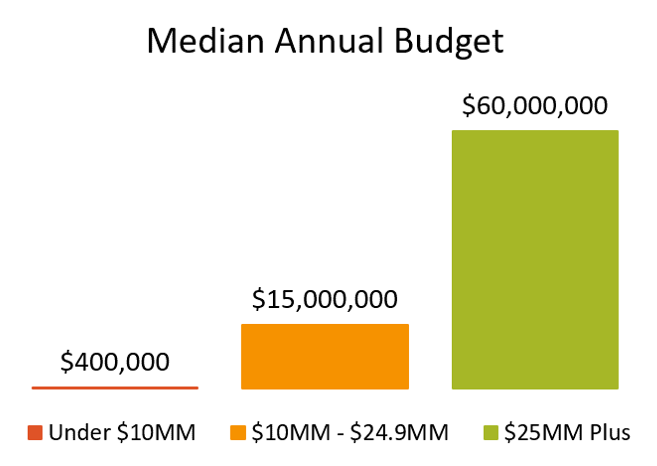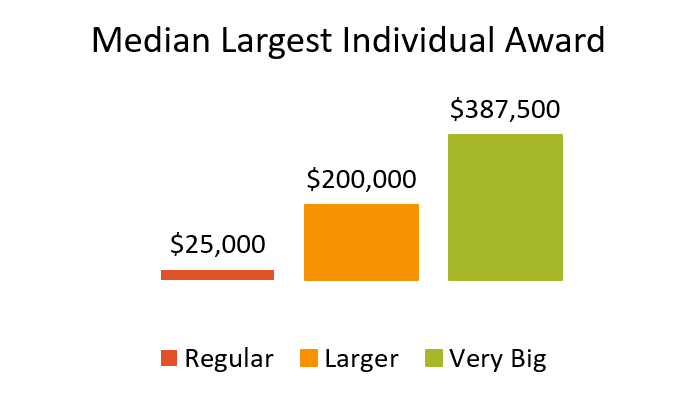
If you’ve read my past blog posts, either here at GS Insights or in GuideStar's blog, you know that I tend to root for the underdog (in fact, literally), the little guy (or NPO) that runs on mission-passion, and the dreamer who perseveres in the face of seemingly insurmountable challenges.
This post isn’t one of those – I’m about to discuss the demographics of very big NPOs. And while it may feel as if the very big nonprofit has everything at the push of a button, they, too have unique challenges.
Let’s start by defining a very big nonprofit – of course, budget is the driving factor – more money means more ability to hire staff and spend time on mission programs and support activities. I define “very big” as annual budget sizes of $25 million and over.
At GrantStation, thanks to nearly 5,000 respondents to the State of Grantseeking Survey and Reports, we have the data to quantify the demographic differences between nonprofits of varying sizes.
Here is a chart showing the median annual budgets of “regular” nonprofits (budgets under $10 million), “larger” nonprofits (budgets between $10 million and $24.9 million), and “very big” nonprofits (budgets $25 million and over).

The increases in budget size translate directly to increases in staff sizes. As you can see, most very big nonprofit organizations (84%) have over 200 staff members.

Of course, very big organizations didn’t get to $25 million or higher budgets overnight. Most very big organizations (73%) were over fifty years old, compared to 51% of larger organizations and 17% of regular organizations. These very big organizations have taken years to prove sustainability and increase capacity, and this is reflected in their infrastructure sizes.

Very large organizations more frequently reported higher indirect and administrative costs over 30% of their annual budget than did other organizations. However, all organizations tended to keep these costs quite low.

Mission focus also defines the very big nonprofit; they are more often educational institutions and healthcare providers than other organizations. This aligns with the median annual budget size by mission focus: $21.5 million for Education, $1.6 million for Healthcare, $1.2 million for Human Services, and $265 thousand for Art, Culture, and Humanities. Mission focus also relates to the very big organization’s staff sizes, especially educational institutions and healthcare providers.

Organizational budget, staff size, age, and mission focus all influence grant funding.

Very big organizations (82%) reported Federal government funding more frequently that larger (63%) and regular (27%) organizations; Federal funding tends to be awarded to organizations that have proven capacity, sustainability, and scope through organizational age, budget, and staff. Our respondents reported a Federal median award size of $337,500; in comparison, the median award size of non-government funders was $25,000.
Very big organizations also reported the highest median individual size; this underscores the frequency of government funding.

Increases in annual budget size, with the implied increases in staff and infrastructure, influenced collaborative activities; very big organizations were also more likely to participate in collaborative grantseeking. Fifty-five percent of organizations with budgets of $25,000,000 or more participated in collaborative grantseeking whereas 40% of larger organizations and 20% of regular organizations participated in collaborative grantseeking. Our respondents told us that collaborative grant seeking can be helpful in the impact and scope of the grant dollars, but often results in extra paperwork and coordination between agencies, which requires staff and time not always available to regular organizations.

However, even organizations with very big budgets and staff sizes face challenges, including challenges to grantseeking.
As you can see, regular organizations most frequently reported the greatest challenge to grantseeking as a lack of time and staff (22%). Larger organizations most frequently said that competition for awards (17%) was the most frequent challenge. And for the very big organization, reduced funding (19%) - ensuring that they have the dollars to support their programs and administration - was by the most frequently reported challenge to grantseeking.
Organizations of all sizes frequently told us that funder practices and requirements were a challenge to successful grantseeking. And, internal organizational issues – “people problems” became a frequently reported challenge grantseeking once an organization had over 75 employees.

Very big nonprofits are similar to all nonprofits in their passion for their mission; they just have to manage a bigger budget, more staff, and a greater scope of services than others.
Should you include this level of growth as a goal in your strategic plan? Keep in mind that it makes sense if you have a recognized mission that requires broad, understandable infrastructure, years of organizational existence, over 75 staff members, and a budget over $10 million – otherwise, it isn’t a viable goal. In addition, if your current and future scope is service is, for example, one county, you may not need to plan for this level of growth, ever.
What all nonprofits can do to ensure continued growth appropriate to their needs is to engage in bold and intentional grantseeking. Cynthia Adams, CEO and founder of GrantStation has written two ePrimers, Bold is Gold: A Funding Research Primer and Intentional Grantseeking: Planning to Win, which will help you incorporate a strong grants strategy within your plans for growth.
Regardless of your growth plans from the very little NPO to the very big NPO, we at GrantStation wish you the very best in meeting your mission.